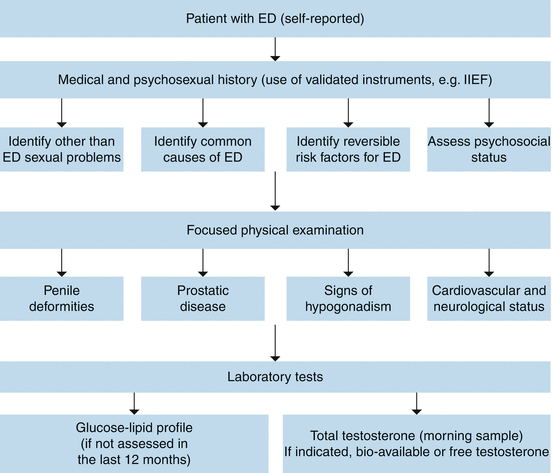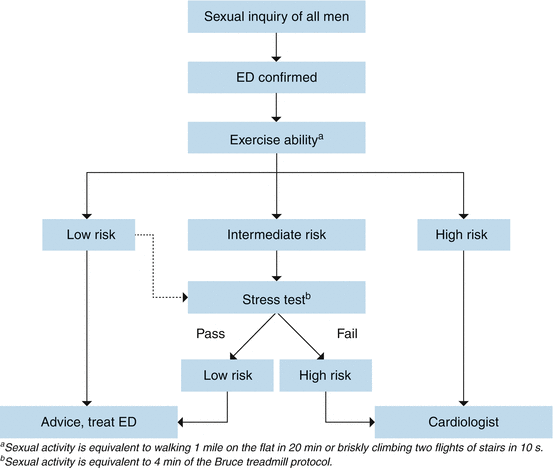LE
Erection is a neuro-vasculo-tissular phenomenon under hormonal control.
2b
ED is common worldwide.
2b
ED shares risk factors with cardiovascular disease.
2b
Lifestyle modification (intensive exercise and decrease in BMI) can improve erectile function.
1b
ED is a symptom, not a disease. Some patients may not be properly evaluated or receive treatment for an underlying disease or condition that may be causing ED.
4
ED is common after radical prostatectomy, irrespective of the surgical technique used.
2b
ED is common after external radiotherapy and brachytherapy.
2b
Clinical Practice: Diagnostic Evaluation
The diagnostic workup of ED patients consists not only of the identification of potential reversible causes for the ED but also includes an examination directed toward identifying underlying and comorbid conditions (diabetes, hypogonadism, prostatic diseases, and neurological or cardiovascular impairments) which should be treated separately.


Clinical Practice: Diagnostic Evaluation, Cardiovascular Risk Assessment
Patients who present with ED have a high prevalence of cardiovascular disease. ED precedes cardiovascular incidents by approximately 3 years and therefore the diagnosis of ED should trigger a cardiovascular risk assessment, which helps to triage those patients who need cardiologists’ evaluation before continuation of ED assessments and treatment.


Clinical Practice: Diagnostic Evaluation Summary
LE | GR | |
|---|---|---|
Clinical use of validated questionnaire related to ED may help to assess all sexual function domains and the effect of a specific treatment modality. | 3 | B |
Physical examination is needed in the initial assessment of men with ED to identify underlying medical conditions that may be associated with ED. | 4 | B |
Routine laboratory tests, including glucose-lipid profile and total testosterone, are required to identify and treat any reversible risk factors and lifestyle factors that can be modified. | 4 | B |
Specific diagnostic tests are indicated by only a few conditions. | 4 | B |
Clinical Practice: Treatment Summary
As a general rule of thumb, every patient presenting with ED can receive PDE5-inhibitors. Failure to respond to PDE5 inhibitors should trigger a discussion on correct use and further evaluation toward why this therapy is insufficient. Generally, vacuum devices, intracavernous injection therapy, and intraurethral applications of alprostadil either in pellet form or in cream form are second choices if there is no response to initial oral therapy or whenever there are contraindications for PDE5 inhibitors use. The issue of penile rehabilitation strategies after radical pelvic surgery is debatable and whether or not treatment should be given as soon as possible after surgery does, in the opinion of the authors, does not warrant a grade A recommendation. This will be further discussed in this chapter. An excellent review on this issue is included in the suggested reading section at the end of this chapter. Low-intensity focused linear shockwave therapy is shortly discussed in the guidelines but evidence is limited and therefore this option was not included in the general treatment recommendation table.
LE | GR | |
|---|---|---|
Lifestyle changes and risk factor modification must precede or accompany ED treatment. | 1a | A |
Pro-erectile treatments have to be given at the earliest opportunity after RP. | 1b | A |
When a curable cause of ED is found, it must be treated first. | 1b | B |
PDE5Is are first-line therapy. | 1a | A |
Inadequate/incorrect prescription and poor patient education are the main causes of a lack of response to PDE5Is. | 3 | B |
A VED can be used in patients with a stable relationship. | 4 | C |
Intracavernous injection is second-line therapy. | 1b | B |
Penile implant is third-line therapy. | 4 | C |
Background
Erectile dysfunction (ED) was defined by the NIH Consensus Development Panel on Impotence as the persistent inability to attain and maintain an erection sufficient for sexual intercourse. While premature ejaculation is probably the most prevalent, ED is without a doubt the most studied male sexual dysfunction and a highly prevalent sexual complaint in men presenting to their healthcare providers. Notwithstanding variations in definitions and methodology, various large-scale studies substantiate the high global prevalence of ED.
Epidemiology
The Massachusetts Male Aging Study (MMAS) is a prospective observational longitudinal study of health in randomly selected men. It investigates the effects of aging on male sexual health, among other domains. This landmark study reported a combined prevalence of minimal, moderate, and complete ED of no less than 52 % in US men. The prevalence of complete ED tripled from 5 to 15 % between subject ages 40 and 70 years. In the European Male Ageing Study (EMAS), a collaborative effort of eight European centers investigating the effects of aging on general and sexual health in a male population aged 40–79 with a mean age of 60 years old, about one-third of the entire EMAS sample reported ED. The prevalence of ED was higher in the older age groups, peaking at 64 % in men over 70 years of age. However, it appears from the results of the EMAS study that although patients in older age groups are more frequently affected by the disease, they tend to be less bothered with the presence of ED. With the rapidly expanding aging population and the increase in life expectancy, an increase in the prevalence of ED is expected in the years to come. It is estimated that in 10 years, about one in ten men of the worldwide population will be older than 65 years of age. By then, the number of men suffering from ED will reach 322 million worldwide.
Comorbid Conditions and ED as a Harbinger of Cardiovascular Disease
While ED does not pose direct threat to physical health, it can have dramatic effects on personal sense of well-being and has a significant impact on the quality of life of patients and their sexual partners. Besides this impact, ED is also an independent predictor of cardiovascular morbidity and mortality. It is frequently postulated that “the penis is the antenna of the heart,” and as such, the complaint of ED should always trigger further questioning and investigation to identify underlying cardiovascular disease or other comorbidities. These other comorbidities are often related to the cardiovascular risk profile and include diabetes mellitus, metabolic syndrome, and smoking. Iatrogenic ED is not uncommon and can be the result of pelvic surgical procedures or the use of various medications. Besides these underlying issues, it is of particular importance to the readers of this book to be aware that community-based, preclinical and clinical data demonstrate a strong and consistent association between LUTS and ED, suggesting that elderly men with LUTS should be evaluated for ED and vice versa. Therefore ED merits consideration from both the primary care physician and the specialist as an important health concern in se and as a potential sentinel for serious health conditions. In this chapter we will discuss the pathophysiology of erectile dysfunction in men and the essentials in ED evaluation and ED treatment.
Prerequisites for Normal Erections and Pathophysiology of ED
Sex drive is the initiator of penile erection, and therefore, intact libido, mood, and psychosocial circumstances are capital to normal erectile function. Penile erection requires neural transmission of pro-erectile impulses, being the efficacious delivery of the neurotransmitter nitric oxide (NO) to the smooth muscle in the corpus cavernosum. Furthermore, an intact arterial blood supply is key to supply the cavernous erectile tissue with oxygenated blood. The end organ, the corpus cavernosum, should be in good health, containing healthy smooth muscle and being elastic to successfully expand and compress the subtunical venous plexus during the rigid phase of erection. Lastly, hormonal balance should be in order as testosterone is a key mediator of libido but also keeps the peripheral effectors, such as cavernous smooth muscle and cavernous nerves, in good shape. ED can develop as result of a failure in one of these systems or, as is commonly the case, a multilevel failure. ED is typically defined as neurogenic, vasculogenic, hormonal, anatomical/structural, drug induced, or psychogenic. A summary of prevalent causes of ED is given in Table 12.1.
Table 12.1
Comorbid conditions and causes for ED
Vasculogenic | Cardiovascular disease; atherosclerosis |
Hypertension | |
Diabetes mellitus | |
Hyperlipidaemia | |
Smoking | |
Major surgery (retroperitoneum) | |
Radiotherapy (retroperitoneum) | |
Neurogenic – central causes | Multiple sclerosis |
Multiple atrophy | |
Parkinson’s disease | |
Tumours | |
Stroke | |
Intravertebral disk disease | |
Spinal cord disorders | |
Neurogenic – peripheral causes | Diabetes mellitus |
Alcoholism | |
Uremia | |
Polyneuropathy | |
Surgery (pelvis or retroperitoneum, radical prostatectomy) | |
Anatomical/structural | Peyronie’s disease |
Penile fibrosis (following pelvic radiotherapy or pelvic surgery) | |
Penile trauma (penile fracture) | |
Congenital curvature of the penis | |
Micropenis | |
Hypospadias, epispadias | |
Hormonal | Primary hypogonadism (e.g., late-onset hypogonadism) |
Secondary hypogonadism/hypogonadotrophic hypogonadism (e.g., hyperprolactinemia) | |
Hyper- and hypothyroidism | |
Cushing’s disease | |
Drug or substance induced | Antihypertensives (thiazides and beta-blockers are most common) |
Antidepressants | |
Antipsychotics | |
Antiandrogens | |
Antihistamines | |
Recreational drugs/smoking | |
Psychogenic | Generalized type (e.g., lack of arousability and disorders of sexual intimacy) |
Situational type (e.g., partner-related or performance-related issues or due to distress) |
Clinical Practice: Diagnosis
History Taking
ED is often multifactorial in origin and is therefore best managed with a holistic approach that includes lifestyle modification, pharmacological management, and importantly counseling of both the patient and his partner. It is of particular importance to encourage open and honest communication between the patient and his partner. All of the above are best facilitated in the context of a trusting patient/provider relationship. Therefore it is critical to establish a comfortable and confidential atmosphere when addressing issues in sexuality with patients. It can be recommended to display literature in the consultation – and waiting rooms indicating a private and nonjudgmental approach toward sexual dysfunctions and more specifically ED. Cultural and ethical beliefs can be a hurdle in communication on sexual functioning and this should be taken into account when evaluating the ED patient.
The initial evaluation of ED should include a complete medical, psychosocial, and sexual history. A thorough medical assessment is mandatory in the evaluation of erectile complaints, with the aim of identifying comorbid or underlying diseases.
Cardiovascular Disease
In the Princeton III consensus, a leading document on the relationship between ED and cardiovascular disease, it is stated that:
ED not only shares risk factors with cardiovascular disease but also is, in itself, an independent marker of increased cardiovascular risk (ACCF/AHA class Ia).
ED is a marker of significantly increased risk of cardiovascular disease, coronary artery disease, stroke, and all-cause mortality.
Incident ED was found to be an independent marker of cardiovascular events (1.5× relative risk) and all-cause mortality (1.2× relative risk) additional to conventional risk factors (e.g., age, weight, hypertension, diabetes, hyperlipidemia, and cigarette smoking). Since ED commonly occurs in the presence of silent CAD, the complaint of ED should always trigger further questioning and clinical examinations aimed at the identification of underlying cardiovascular disease. Typically, a time window between ED onset and the occurrence of a coronary artery disease event is 2–5 years (class Ia); thus ED provides an excellent opportunity for cardiovascular risk reduction. It is thus evident that the ED patient is entitled to a thorough analysis of classical cardiovascular risk factors such as smoking, dyslipidemia, hypertension, and a positive family history for cardiovascular events. A cardiovascular anamnesis allows stratification of patients in low-cardiovascular-risk, intermediate-risk, and high-risk group and to identify those who need a cardiologist’s evaluation before resuming sexual activity (see the flow diagram in “what do the guidelines say”). Cardiovascular conditions and their risk categories are detailed in Table 12.2.




Table 12.2
Cardiovascular risk assessment in ED patients
< div class='tao-gold-member'>
Only gold members can continue reading. Log In or Register to continue
Stay updated, free articles. Join our Telegram channel

Full access? Get Clinical Tree








